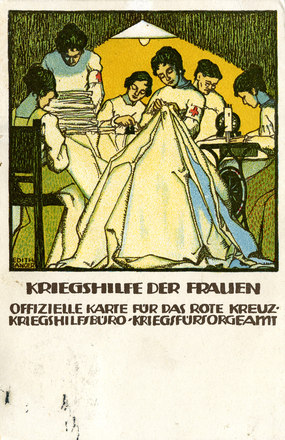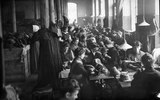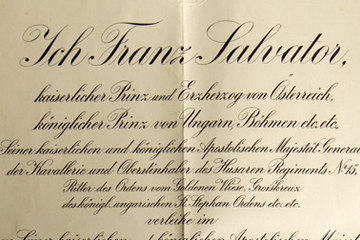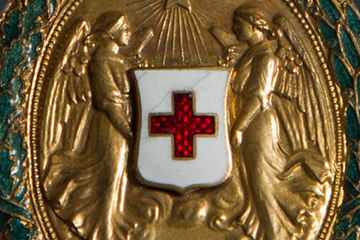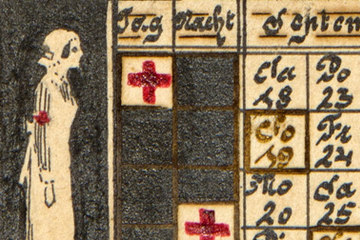The consequences of the First World War reached unprecedented proportions. The war penetrated the lives of civilians, and the home(land) itself was turned into a theatre of war. Women and children, too, were called upon to play an active role in the war effort through war welfare and assistance societies, and to do their bit for the Fatherland.
The term ‘home front’ describes the war work carried out by those ‘back home’ and emphasizes its significance for the war effort. The boundary between the front and home was, then, no part of the reality of war; rather, it existed in the imaginary world of the soldiers and the women who feared for their lives. The wide-scale involvement of women – whether as workers in the military-industrial complex or as volunteers in field hospitals – thus mitigates the notion of war as ‘men’s business’.
Women were mobilized in the service of the Fatherland even at the start of the war:
We call on Austria’s women to play their part in the war effort! In this moment, all women must be brought together in the greatest solidarity. Their willingness to work must become a reality, and all voices of opposition must be silent. [...] The family that is suddenly robbed of its breadwinner must be protected from the worst through women’s unity, women’s strength and women’s work.
This appeal was published by Frauenhilfsaktion im Kriege [Women’s War Assistance], which was founded a few days after the outbreak of war. It was, in fact, an umbrella organization which united various women’s organizations, including the Reichsorganisation der Hausfrauen Österreichs [Organization of Austrian Housewives], the Sozialdemokratische Frauenorganisation [Organization of Social-Democratic Women] and the liberal-bourgeois Bund österreichischer Frauenvereine [League of Austrian Women’s Associations] across party lines. The Frauenhilfsaktion called for unity among all women, pointing to the purportedly typical feminine attributes of care and motherliness. It collected donations for the front, helped out-of-work women who were looking for employment and set up sewing and knitting workshops where women made clothing and blankets for the army and hospitals in exchange for a small wage.
Women who were materially better off also volunteered their services, for example by knitting gloves and wrist warmers for the soldiers at the front. Needy working women saw the sewing and knitting of the upper-class and aristocratic women as a threat to their already precarious employment situations.
Women also undertook other voluntary work to help in the war effort, including preparing food and clothing for injured soldiers and making what were known as ‘Liebesgaben’ [alms, literally ‘gifts of love’] – parcels containing refreshments or warm knitted items. These were sent to provide soldiers on the front with emotional support. Newspapers printed precise instructions for making mittens, waist warmers and winter hats. Because the troops were so ill-equipped, the sewing and knitwear produced by the women and girls was declared a necessity of war.
The women who were involved in various forms of war work on the ‘home front’ made a significant contribution to the war effort. But while their activities were now for the first time publicly valued, and were seen as vital for both the state and the national economy, traditional gender rolls remained intact. Ultimately, women were called upon to serve the Fatherland through the supposedly feminine virtues of sacrifice, love and care.
Translation: Aimee Linekar
Bauer, Ingrid: Frauen im Krieg. Patriotismus, Hunger, Protest – weibliche Lebenszusammenhänge zwischen 1914 und 1918, in: Mazohl-Wallnig, Brigitte (Hg.): Die andere Geschichte 1. Eine Salzburger Frauengeschichte von der ersten Mädchenschule (1695) bis zum Frauenwahlrecht (1918), Salzburg 1995, 285-310
Granitsch, Helene: Kriegsdienstleistung der Frauen, Wien 1915
Hämmerle, Christa: „Wir strickten und nähten Wäsche für Soldaten…“ Von der Militarisierung des Handarbeitens im Ersten Weltkrieg, in: L´Homme. Zeitschrift für Feministische Geschichtswissenschaft (1992) 1, 88-128
Hämmerle, Christa: „Habt Dank, Ihr Wiener Mägdelein…“ Soldaten und weibliche Liebesgaben im Ersten Weltkrieg, in: L´Homme. Zeitschrift für Feministische Geschichtswissenschaft (1997) 1, 132-154
Hämmerle, Christa: „Zur Liebesarbeit sind wir hier, Soldatenstrümpfe stricken wir …“ Zu Formen weiblicher Kriegsfürsorge im Ersten Weltkrieg (unveröffentlichte Dissertation), Wien 1996
Healy, Maureen: Vienna and the Fall of the Habsburg Empire. Total War and Everyday Life in World War I, Cambridge 2004
Heeresgeschichtliches Museum: Die Frau im Krieg. Katalog zur Ausstellung vom 6. Mai bis 26. Oktober 1986, Wien 1986
Quotes:
"We call on Austria’s women …“: Aufruf der Frauenhilfsaktion im Kriege, quoted from: Granitsch, Helene: Kriegsdienstleistung der Frauen, Wien 1915, 8 (Translation)

